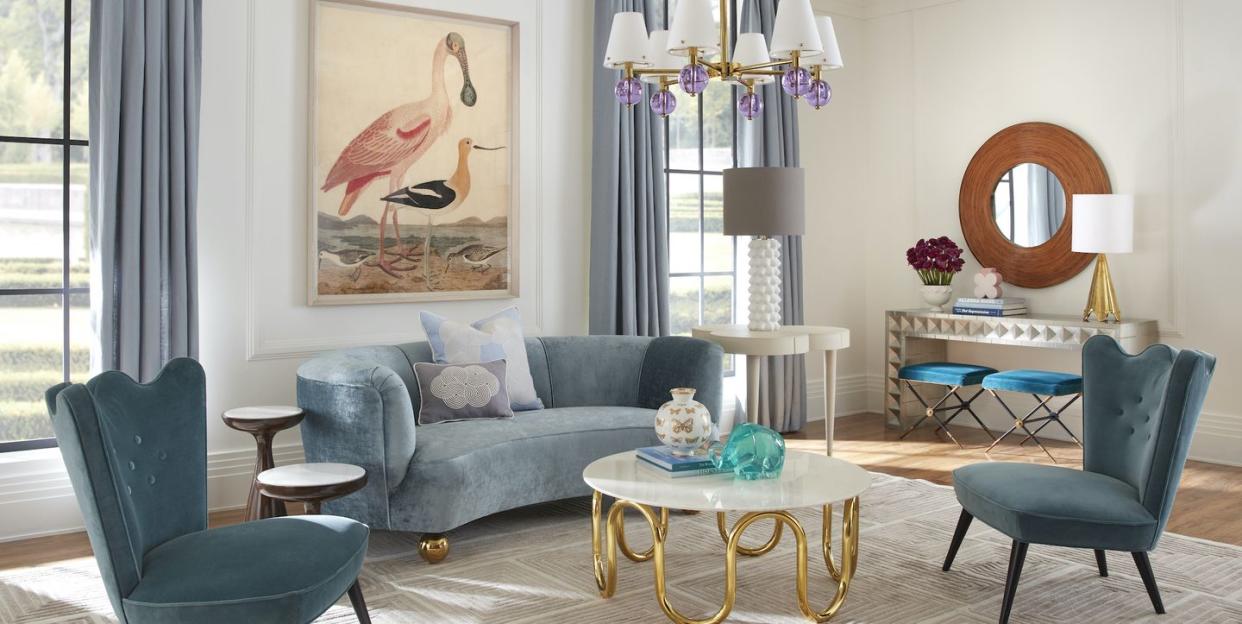This Victorian-Era Chair Is Making Its Comeback

Much like fashion, design tends to usher in trends from the past. Case in point: Nesting tables, slipper chairs, and highboy dressers, all of which had a moment last century and are making a triumphant return. In fact, we aren’t the only ones convinced that these elegant styles are on their way back. Inspired by our recent “Small Spaces” issue, which is on stands now, we chatted with three interior designers, Santa Monica-based Sarah Rosenhaus, Dallas-based Hope Danyla, and Pacific Palisades-based Casey Hill, who shared their hot takes on the new trends.
Nesting Tables
As its name implies, nesting tables come in a set of descending sizes. Perhaps the most famous nesting tables are by Bauhaus designer Josef Albers whose bright and colorful series popularized the unique concept. Ahead, Rosenhaus, a devoted nesting tables fan, offers some advice on styling and using nesting tables in your space.
Style Them Like Any Other Table
“I would style a nesting table like any other side table. When using it next to a sofa, consider styling it with a beautiful lamp, perhaps a stack of pretty coasters, and a small floral arrangement,” she suggests. “When using between chairs, you may want to leave the table empty or decorate minimally with a vase or an interesting ceramic piece.” One more thing: The designer advises against piling your nesting tables with clutter. Instead, opt for delicate layers of accessories.
Give Them a Moment
“There is so much versatility in having a stacking group of tables. You can arrange them next to a piece of furniture or even under a window as its own moment,” she adds. “I especially love grouping modern tables in multiple colors to add a pop of fun.” In other words, if you’re using a set of nesting tables, let them stand out rather than blend in with the rest of your space.
Place Them in the Living Room
Though nesting tables aren’t specifically designated to any one room, Rosenhaus urges using them in the living area. “Nesting tables are great in the living room where they can be arranged beside a sofa or between a pair of chairs. They immediately add an extra layer of interest.” What’s more: The designer suggests using them as a pedestal for a large floral arrangement or sculpture.
Slipper Chairs
Slipper chairs may not be as necessary now as they were when they first made an appearance during the Victorian era, but they haven’t lost their luster. Back then, the armless, low-profile seats were designed to make it easier for upper-class women to bend over and put on their shoes. Danyla thinks these ages-old chairs are on the rise again and explains how she’d incorporate them into any design scheme.
Maximize the Look
“When it comes to styling a slipper chair, I love to maximize the look. A favorite styling trick for clients is to add a throw blanket with a lot of texture and a pillow that contrasts with the chair’s upholstery,” she notes. “The final styling element for a slipper chair that creates the perfect vignette is a side table that is visually light in weight. It adds a surface for setting a drink or a good read. Plus it creates balance for the larger presence of the chair.” You may even opt for a set of low-profile nesting tables!
Dress It Up
Naturally, these are not the most formal chairs since they weren’t exactly designed to be seen back in the 19th century. Danyla says, “Since these chairs don’t have arms, they are less sophisticated than a club chair that you may find in a study or a wingback chair that is generally more decorative.” Her tip? Opt for a slipper chair in a bold, patterned fabric or a deep, saturated hue. “If you have a space that needs some infused personality, slipper chairs are the perfect addition,” she adds.
Maintain a Sense of Intimacy
“A slipper chair is wider and lower to the floor compared to most occasional chairs, and due to their build, they can make a space feel comfortable and less ‘nervous’ than a formal space,” Danyla offers. With that in mind, she likes to incorporate slipper chairs in spaces that already have a sense of intimacy, like the area surrounding a fireplace.
Highboys
The term “highboy” is a more efficient way of saying “tall dresser.” So if you have a small space with little room to spare, a highboy may be the perfect storage piece for you. Hill weighs in on how she’d expertly incorporate highboys into just about any bedroom.
Style It Well
“I have often used a pretty box or basket placed on top of the dresser to store meaningful keepsakes, books, or objects that are handmade and artisanal to offset the more masculine form of a highboy,” she explains. If you want to take the extra step into softening the hard aesthetic edge of a classic highboy, Hill suggests, “A more feminine chair placed next to it displays a nice juxtaposition of form.”
Refine the Style
“The design of the highboy, to place a chest of drawers on a stand with turned legs, is quite handsome and pared back, so I wouldn’t recommend going overboard with decoration,” the designer says. So when you’re picking out a highboy, opt for a classic, quietly luxurious one that seamlessly blends with your space.
Keep It in the Bedroom
Unlike a set of nesting tables, highboys are best suited in bedrooms. “I find them most fitting in a bedroom or dressing room,” Hill agrees. “A highboy provides great storage for everything you’d need in such spaces, including clothes or accessories.”
Follow House Beautiful on Instagram.
You Might Also Like

